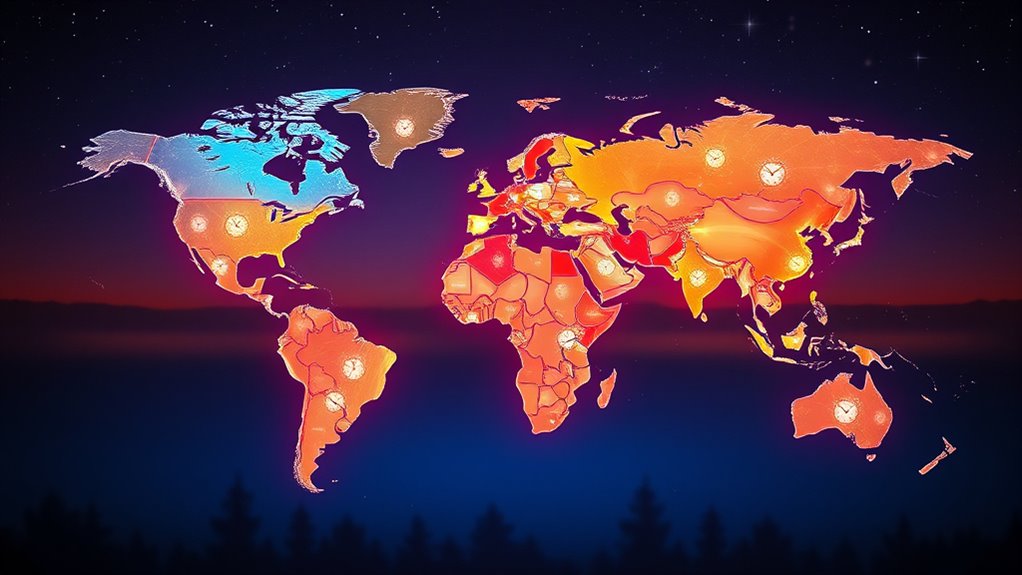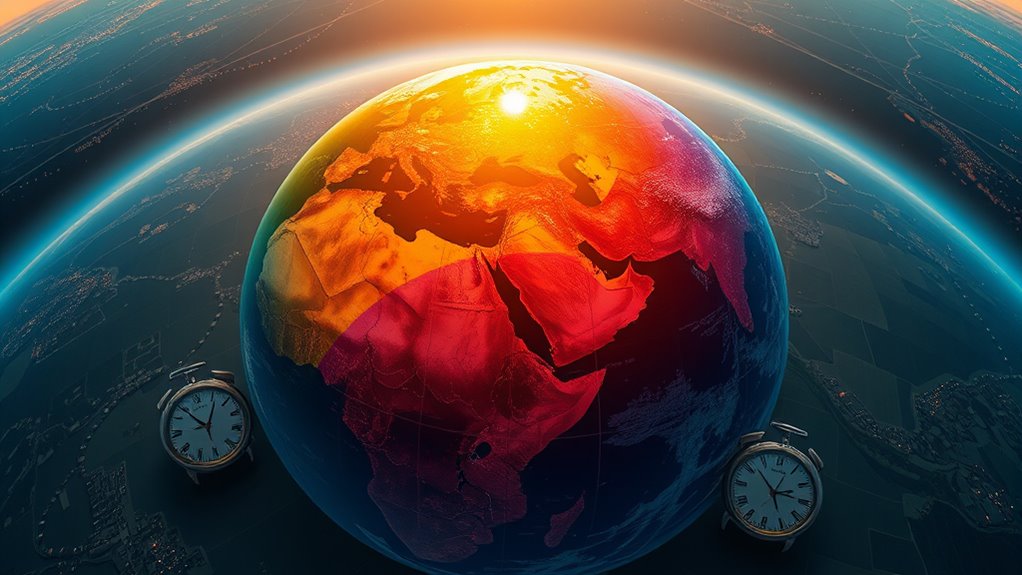Different parts of the world have different times because the Earth is divided into 24 time zones, each reflecting the sun’s position. This system helps you coordinate activities across vast regions. The boundaries, like the International Dateline, change the calendar day when crossed. Daylight Saving Time further complicates this by shifting clocks to optimize daylight. By understanding how time zones work, you’ll see how they impact your scheduling and travel plans. There’s so much more to discover!
Key Takeaways
- Earth is divided into 24 time zones, each representing one hour of solar time based on the planet’s rotation.
- Time zones help coordinate activities globally by accounting for the varying position of the sun across regions.
- The International Dateline marks where calendar days change, impacting timekeeping during international travel.
- Daylight Saving Time adjusts clocks to optimize daylight use, further complicating time differences in various regions.
- Understanding time zones is essential for effective planning in communication, travel, and business across different locations.

Have you ever wondered why the sun rises at different times across the globe? It’s all about time zones, a system developed to help us keep track of time as our planet spins on its axis. Earth is divided into 24 time zones, each generally spanning 15 degrees of longitude. When the sun shines on one part of the world, it’s dark in another. This clever division helps you coordinate activities across various regions.
The International Dateline plays a pivotal role in defining these time zones. Imagine standing at this imaginary line, which runs roughly along the 180th meridian. When you cross it, you either gain or lose a day, depending on the direction you’re heading. If you travel west across the Dateline, you move into tomorrow; if you go east, you’re stepping back into yesterday. This unique feature is particularly important for international travel and communication, ensuring that everyone’s on the same page, at least time-wise.
Now, let’s talk about Daylight Saving Time. You might’ve noticed that your clocks spring forward in spring and fall back in autumn. This practice, which affects many countries, shifts the clock to make better use of daylight during the longer days of summer. While it aims to save energy and increase outdoor activities in the evening, not everyone agrees on its effectiveness. Some regions have opted out entirely, sticking to standard time year-round. This can create some confusion when scheduling calls or meetings, especially across different time zones.
Daylight Saving Time shifts our clocks to maximize daylight, but it can complicate scheduling across time zones.
When you combine time zones with Daylight Saving Time, you’re faced with an ever-changing landscape of hours. For instance, if you’re in New York, which observes Daylight Saving, and you want to call someone in Los Angeles, you need to remember there’s a three-hour difference when both regions are on standard time, and only two hours when New York shifts forward.
Understanding these nuances can feel overwhelming, but they’re essential for charting your course through our interconnected world. Time zones, the International Dateline, and Daylight Saving practices help you manage your day, whether you’re planning a trip, setting up a meeting, or simply checking in with friends around the globe. Reliable backup power systems can also play a role in keeping you connected and productive during unforeseen events. So next time you wonder about the time differences, remember—there’s a method to the madness!
Frequently Asked Questions
How Do Time Zones Affect International Business Operations?
Time zones considerably impact international business operations. You’ve gotta manage time zones effectively for smooth communication and business synchronization across different regions. If you don’t, delays in response times can lead to missed opportunities. Scheduling meetings becomes tricky, and project timelines might suffer. By prioritizing time zone management, you can streamline operations, enhance collaboration, and guarantee that your global team works cohesively, ultimately driving success for your business.
What Is the History Behind the Establishment of Time Zones?
The history behind the establishment of time zones dates back to the late 19th century. As railways expanded, the need for standardized time became essential. You’ll find that Sir Sandford Fleming proposed dividing the world into 24 time zones in 1879, leading to international agreement at the 1884 Greenwich Conference. This development helped synchronize schedules and improved communication and travel, shaping how society functions across different regions today.
How Do Daylight Saving Changes Impact Time Zones?
Daylight saving changes impact time zones by shifting clocks forward or back, affecting daily schedules. For instance, when you spring forward an hour in March, your usual 8 AM meeting suddenly feels like 9 AM. This time adjustment can confuse travel plans, especially if you’re flying to a different zone. You might find yourself scrambling to adjust your itinerary, as local times vary widely, leading to potential missed connections or appointments.
Are There Any Regions Without a Designated Time Zone?
Yes, there are unclaimed regions and undisputed zones without a designated time zone. Places like Antarctica have no official time zone due to their extreme conditions and lack of permanent residents. In these areas, people often use the time zones of their home countries or the nearest research stations. So if you find yourself in one of these regions, you might have to decide which time zone to follow based on your needs.
How Do Time Zones Influence Travel and Flight Schedules?
Time zones can turn your travel dreams into a jet lag nightmare! When you hop on a flight, you’re not just changing altitude; you’re leaping through time itself. Timezone conversion can feel like a cosmic trick, leaving you wondering if you’ve actually entered a sci-fi movie. You’ll arrive at your destination, but your body might still be in a different time zone, making every hour feel like an eternity. Buckle up and adjust fast!
Conclusion
In summary, understanding time zones helps you grasp how the world operates on different schedules. Did you know that the Earth is divided into 24 standard time zones, each roughly 15 degrees apart? This means that as you travel east or west, you could experience a time change of up to 24 hours! So, next time you make plans across time zones, remember the fascinating complexity of our planet’s rotation and how it shapes your daily life.










